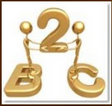SALAM....
hai fellow friends... semoga nota saya ini mmberi manfaat buat anda semua...
1.
E-BUSINESS
The internet is a
powerful channel that presents new opportunities for organization to:
i.
Touch customer
ii.
Enrich products and
services with information
iii.
Reduce costs
How do E-commerce and E-business differ?
E-commerce: the buying
and selling of goods and services over the internet. Mostly refer to online
transactions.
E-business: the
conducting of business on the internet including, not only buying and selling,
but also serving customers and collaborating with business partners
Figure 1: Examples of
several industries that using E-business
2.
E BUSINESS MODELS
Ø An approach to conducting electronic business on the
Internet
Figure 2: Basic e-business model
Figure 3: Overview of e-business model
Figure 4: Basic
e-business model Definitions
i.
Business-to-Business (B2B)
Ø Applies to
business buying from and selling to each other over the internet.
Ø E.g.: Intel
selling microprocessor to DELL
Heinz selling
ketchup to McDonald
· Online access to data, including expected shipping
date, delivery date and shipping status, provide either by the seller / third
party provider.
Electronic marketplaces/ E market place: interactive
business communities providing a central market where multiple buyers and
sellers can engage in e business activities.
·
They present structures for conducting commercial
exchange, consolidating supply chain and creating new sales channels
i.
Business-to-Consumer
(B2C)
Ø Applies to
any business that sells its products/ services to consumers over the internet.
Common B2C e business models include:
a. E-shop: A version of retail store where customers can shop at
any hour of the day without leaving their home or office
b. E-mall: Consists of a number of e shops; it serves as a
gateway through which a visitor can access other e shops
Types of business:
i.
Brick-and-mortar
business: a business that operates in a
physical store without an internet presence
ii. Pure-play
business: a business that operates on the
internet only without a physical store such as Amazon
iii.
Click-and-mortar business: a business that operates in a
physical store and on the internet.
Online auction:
a) Electronic auction (e-auction): sellers and buyers solicit
consecutive bids from each other and prices are determined dynamically.
b) Forward auction: an
auction that sellers use as a selling channel to many buyers and the highest
bid wins.
c) Reverse auction: an auction that buyers use
to purchase a product or service selecting the seller with the lowest bid.
iii.
Consumer-to-Business (C2B)
Ø Applies to
any consumer that sells a product/ service to a business over the internet.
Ø E.g.:
Priceline.com
The demand
for C2B e business will increase over the next few years due to customer’s
desire for greater convenience and lower prices
iv.
Consumer-to-Consumer (C2C)
Ø Applies to
sites primarily offering goods and services to assist consumers interacting
with each other over the internet.
Ø It is where
consumer sell directly to other consumers
Ø Examples:
eBay, online auction website, second hand product
C2C communities include:
a. Communities of interest: People interact with each other on specific topics, such as golfing and
stamps collecting.
b. Communities of relations: People come together to share certain life experiences, such as cancer
patients, senior citizens, and car enthusiasts.
c. Communities of fantasy: People participate in imaginary environments, such as fantasy football
teams and playing one-to-one with Michael Jordan.
3. EBUSINESS
BENEFITS AND CHALLENGES
E business
benefits:
i.
Highly accessible
ii.
Increased customer loyalty
iii.
Improved information
content
iv.
Increased convenience
v.
Increased global
reach
vi.
Decreased cost
E business
challenges:
i. Protecting consumers
ii. Leveraging existing systems
iii. Increased liability
iv. Providing security
v. Adhering to taxation rules
The advantages
and limitations in e business revenue models:
a) Transaction fees
b) License fees
c) Subscription fees
d) Value-added fees
e) Advertising fees
4. MASHUPS
Web mash up: A Web site or Web application that uses content from more
than one source to create completely new services
Application programming interface (API):
A set of routines, protocols, and tools
for building software applications
Mash up editor: WSYIWYGs (What You See Is What You Get) for mash
ups









No comments:
Post a Comment